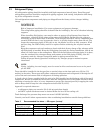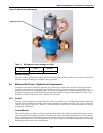
Air-Cooled Models—Self-Contained Compressor
32
6. After four hours, check the pressure readings and, if they have not changed, break vacuum with
dry nitrogen. Pull a second and third vacuum to 250 microns or less. Recheck the pressure after
two hours.
7. Remove the jumper hose installed previously from between the service valve fitting and the
condenser. After completing this step, proceed to Lee-Temp Charging.
Lee-Temp Charging
1. Check unit nameplate for refrigerant type to be used. Unit control configurations differ depending
on refrigerant type.
2. Refrigerant charging requires unit operation. Refer to 2.9 - Checklist for Completed
Installation.
3. Calculate the amount of charge for the system. Refer to the unit, condenser and refrigerant line
charge data in Tables 6, 7, 8 and 9.
4. Weigh in as much of the system charge as possible before starting the unit.
5. Turn on unit disconnect switch. Operate the unit for 30 minutes using the charging function for
the system in the diagnostic section of the Liebert iCOM control. The charging function operates
the compressor at full capacity and energizes the blower motor and liquid line solenoid valve. The
reheat and humidifier are disabled. A minimum 20psig (138kPa) must established and
maintained for the compressor to operate. The charging function can be reset as many times as
required to complete unit charging.
6. Charge the unit until the liquid line sight glass becomes clear. Then add one additional pound
(2.2 kg) of refrigerant.
Lee-Temp Receiver Refrigerant Level
On each receiver at the condenser are two refrigerant-level sight glasses. Refrigerant level will vary
with outside temperature. Check refrigerant level after the unit has been on for at least 15 minutes.
Sight Glass Levels
40°F (4.5°C) and lower—bottom sight glass is 3/4 full
40 to 60°F (4.5 to 15.5°C)—bottom sight glass is full
60°F (15.5°C) and higher—top sight glass is 3/4 full.
!
CAUTION
Risk of improper refrigerant charging. Can cause equipment damage.
Refrigerant R407C is a blend of three components and must be introduced and charged from
the cylinder only as a liquid.
When adding liquid refrigerant to an operating system, it may be necessary to add the
refrigerant through the compressor suction service valve. Care must be exercised to avoid
damage to the compressor. Emerson recommends connecting a sight glass between the
charging hose and the compressor suction service valve. This will permit adjustment of the
cylinder hand valve so that liquid can leave the cylinder while allowing vapor to enter the
compressor.
Table 11 Lee-Temp suction pressure transducer settings
Function
R-407C
Gauge Reading
(Sea Level) Absolute
psiG (kPa) psiA (kPa)
Pump-Down Cutout 20 (138) 35 (241)
Pump-Down Reset 65 (448) 80 (552)
Minimum to Start-Cooling 50 (345) 65 (448)
Low-Pressure Cutout (DX only) 52 (358) 67 (461)
NOTE
A digital scroll compressor will have a clear sight glass only when operating at 100% capacity.
When operating below 100%, the sight glass may show bubbles with each 15-second unloading
cycle.


















